|
The
full moon has risen over the snow-capped peaks of the La Sals,
casting nighttime shadows as we walk across the open desert.
Though the light is bright enough to see by, we bring flashlights
for our foray. Tonight’s search - to see if there is
a tiger in this tank.
We don’t seek the feline variety, rather Ambystoma tigrinum
- the Tiger Salamander. The adult salamanders are black or
sooty colored with a banded or mottled tiger-stripe like pattern,
hence, their common and species name. The genus name, Ambystoma,
means “two mouths” in reference to the sharp,
“eyeteeth” of the juveniles and the bicuspid teeth
of the adults.
Some might consider the predatory nature of the salamander
sufficient to associate this amphibian with its mammalian
counterpart. Adult salamanders feed on earthworms, insects,
mice and other amphibians. And in the juvenile stage, with
their sharp pincer teeth, they can be just as carnivorous.
We reach the stock pond at the base of a sandstone projection.
Winter and spring runoff have filled this pool to overflowing.
Though dry last year, the rains have replenished this habitat
for a number of aquatic species. Even if we didn’t know
where the pond was, we could have easily followed the sounds
of chorusing red-spotted toads, their trilling calls leading
us to this oasis. Our lights illuminate numerous male toads,
and their single vocal sacs extended helping to resonate their
bleating mate-attracting calls.
Though the pond is full, we search the shallows along the
edge for our desert tigers. We don’t expect to see adults
- that would be a real treat, rather we search for the aquatic
larvae nicknamed mud puppies. Seeing this underwater juvenile
stage is a strange sight. Resembling huge tadpoles, the larvae
have large heads, four small spindly legs, and three pairs
of external gills that resemble bird feathers. The long, laterally
flattened tail helps propel the larvae through the water as
they search for amphibians, aquatic invertebrates, and smaller
salamanders. Of course, these aquatic tigers may also be predated
upon by fish, but not in this tank. Here they are the kings
of the pond.
Interestingly, some of these juvenile individuals remain as
permanent larvae, and never mature into adults. Called an
axolotl, it is not well understood why these larvae never
metamorphose into adults. In some artificial habitats, such
as this stock pond that doesn’t normally dry out, these
larvae take advantage of the permanent food resources and
grow sex organs and breed in the pools. If the pond does dry
up, like last year, the larvae may change into adults and
either move to another pool or burrow into the wet mud.
As we cast our beams across the water, we locate several of
these aquatic larvae. They propel themselves along with their
long laterally-flattened tails in a back-and-forth motion
called sculling. Their small legs are almost useless, but
they do help maintain a bearing as the juveniles move through
the water. Leery of our presence, the salamanders glide away
into the darker recesses of the pond.
As the nighttime temperature drops, we pull on sweatshirts
and continue our vigil. The toads have not grown quite, although
they temporarily stop chorusing when we pass by them. We have
to be careful where we step, for often the toads bump against
our feet. We feel fortunate to observe this desert phenomenon,
made more amazing by the nature of the habitat - a pond of
water in the desert.
Having enjoyed our amphibious serenade and the watery parade
of salamanders we gather our packs and head back to our vehicle.
I am reminded of a Madison Avenue gasoline advertizement from
my youth, something to do with putting “a tiger in your
tank.” The inference was for additional automotive power,
but tonight that phrase takes on a whole new meaning.
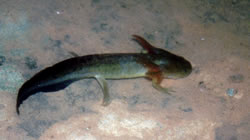
|
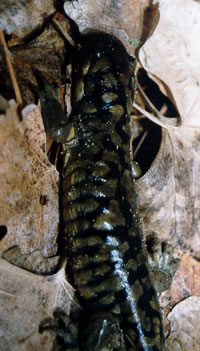
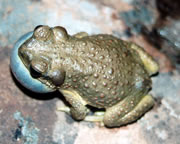
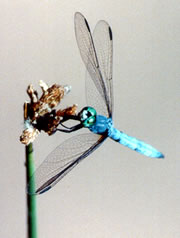
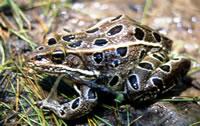
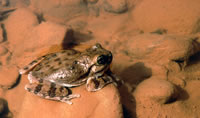
|
 NATURE
HAPPENINGS - May 2003
NATURE
HAPPENINGS - May 2003




